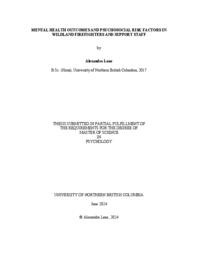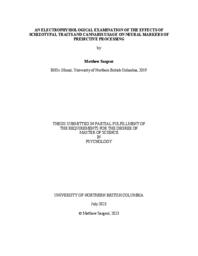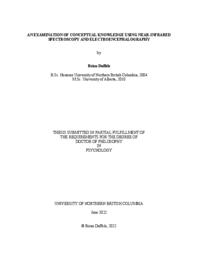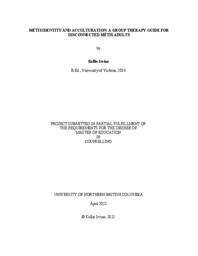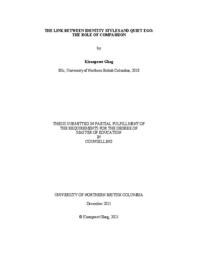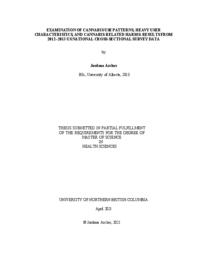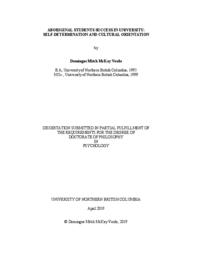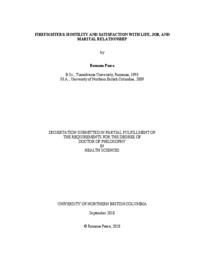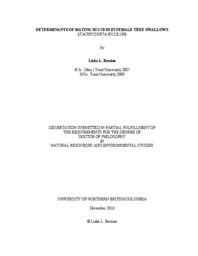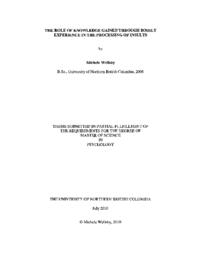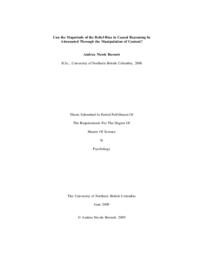Siakaluk, Paul D.
Person Preferred Name
Paul D. Siakaluk
Affiliation
Related Works
Content type
Digital Document
Origin Information
Content type
Digital Document
Origin Information
Content type
Digital Document
Description / Synopsis
The brain’s ability to make predictions has long been of interest to cognitive neuroscientists, who have used techniques including electroencephalography (EEG) to study this phenomenon. A component of neurophysiological activity, termed the Semantic Predictive Potential (SPP), may be an indicator of people’s ability to predict the nature of upcoming semantic content. Interestingly, a body of theoretical and experimental work suggests that people with schizophrenia and people who regularly use cannabis have difficulty making predictions about information in their environments. We explored how schizophrenia-like traits and cannabis use affected the SPP. Participants read sentences which differed in the predictability of their endings while brain activity was monitored using EEG. Participants then completed questionnaires assessing their levels of schizophrenia-like traits and cannabis use. We replicate previous findings suggesting that the SPP is sensitive to semantic predictability, and show that schizophrenia-like traits and cannabis use interact with semantic predictability to influence the SPP.
Origin Information
Content type
Digital Document
Description / Synopsis
Traditionally, models of conceptual knowledge have relied upon amodal theories that largely overlook how environmental stimuli are converted into amodal representations and how perceptions reactivate these representations and translate them back into subjective modal experiences. Developed more recently, grounded cognition theories propose that physical experiences and conceptual knowledge rely, at least in part, on the same brain regions. Thus, conceptual knowledge is hypothesized to be experienced through the reactivation of the same brain regions that are activated during physical experiences with the environment. Furthermore, if these grounded hypotheses are correct, researchers should be able to observe predictable influences of grounded information on brain activity as well as participant response latencies and accuracy in experimental conditions. To this end, three experiments were conducted testing these hypotheses using semantic categorization tasks while simultaneous recordings were taken using functional near infrared spectroscopy (NIRS) and electroencephalography. It was hypothesized that the influence of automatically reactivated grounded information would be facilitatory (i.e., resulting in faster and more accurate responses for semantically richer words) when it was task congruent, but would be inhibitory (i.e., resulting in slower and less accurate responses for semantically richer words) when it was task incongruent, thus illustrating the automatic simulation of grounded information in the processing and retrieval of conceptual knowledge. NIRS was employed to monitor event-related patterns of prefrontal cortex (PFC) hemodynamics associated with these tasks. It was hypothesized that trials with high levels of task-relevant semantic information would be discernably different than those with low levels or those trials high in task-incongruent information. That is, given the high levels of task-relevant semantic information, these trials should be comparatively easier, thus requiring less activity in the PFC, resulting in less pronounced hemodynamic responses. Electroencephalography was employed to monitor the full-scalp event-related patterns of brain activity associated with the experimental tasks. It was hypothesized that event-related potential deflections and scalp topography would be able to discern qualitatively and quantitatively different patterns of activity as a function of the amount and relevance of grounded information obtained through physical and emotional experiences with the word stimuli’s referents. The behavioural, accuracy, and electroencephalography data generally support these hypotheses. When a stimulus’s grounded information is high and task relevant, participants responded more quickly and accurately, and had discernably different patterns of brain activity than when a stimulus’s grounded information was low and task relevant. When a stimulus’s grounded information was high and task-irrelevant, participants were slower and less accurate, and exhibited patterns of brain activity that reflected both the additional semantic information and the additional processing necessary to reconcile the task incongruence. Unfortunately, data obtained from NIRS failed to illustrate meaningful condition differences. Possible reasons for this are discussed in detail in Chapter 3. Collectively, the data presented in this dissertation serve to advance and extend the claims made by grounded cognition theorists by illustrating the automatic simulation of information obtained through interactions with the environment. Further research is required to extend this work to other brain regions and to develop NIRS methods that can address these research questions.
Origin Information
Content type
Digital Document
Description / Synopsis
The Métis are a large population of Indigenous peoples who inhabit Turtle Island, otherwise known as North America. Due to the well-documented deleterious effects of colonization on Indigenous peoples, some Métis remain disconnected from their culture and have grown up with little to no knowledge of their Métis heritage. This project suggests an outline for a Métis-specific group therapy for adults who grew up outside of the community and wish to connect to other Métis in a meaningful way. The project will guide readers through the culturally specific complexities of adopting a Métis identity, as well as suggest methods and perspectives for the Western counsellor to implement in building a positive therapeutic relationship with both Métis individuals and communities.
Origin Information
Content type
Digital Document
Description / Synopsis
Grounded cognition is a theoretical stance that suggests that sensorimotor simulation is constitutive of knowledge. I sought to investigate the role of sensorimotor simulation in higher-level conceptual tasks, such as reading and categorization. Body Ownership Illusions (BOIs) were used to interfere with effector-specific representations. Using Representational Similarity Analysis (RSA) of Electroencephalographic (EEG) data, I identified time points during which representations of different information were active. The neural geometry was compared to two different hypothesized representational geometries. The hypothesized representational geometries were constructed from ratings about effector and sensorimotor information. During the control conditions, two distinct types of information were represented early in the epoch: information about the effector and information about the sensorimotor profile of the word. In the illusion condition, both effector and sensorimotor information representations were pushed to later time points in the epoch. These results demonstrated that sensorimotor and effector information are represented when reading in normal conditions, which supports a weak grounded cognition position, whereby sensorimotor information is activated as we understand concepts. In the illusion conditions, the typical representation of action concepts was disrupted, supporting the hypothesis that BOIs could be used to interfere with concept representation during the understanding of verbs. Effector-specific illusions effects were inconclusive; there was no consistent pattern for hand words in the hand illusion or foot words in the foot illusion. Thus, I did not provide evidence that the information that serves concept representation is effector specific.
Origin Information
Content type
Digital Document
Description / Synopsis
Relationships between the identity styles (informational, normative, and diffuse-avoidant), compassionate love for humanity, self-compassion, and quiet ego were explored. To date, no research has examined relationships between these constructs. Three hundred four individuals (84 men and 220 women) completed self-report measures of identity style, compassionate love for humanity, self-compassion, and quiet ego. Participants were members of an age range referred to as emerging adults (ages 18 to 29). Seven hypotheses were investigated, including whether: (1) there will be a significant positive relationship between the informational identity style and quiet ego; (2) there will be a significant negative relationship between the normative identity style and quiet ego; (3) there will be a significant negative relationship between the diffuse-avoidant identity style and quiet ego; (4) the informational identity style positively predicts quiet ego, with high self-compassion being a mediating factor; (5) the informational identity style positively predicts quiet ego, with high compassionate love for humanity being a mediating factor; (6) the normative identity style negatively predicts quiet ego, with low compassionate love for humanity being a mediating factor; and (7) the diffuse-avoidant identity style negatively predicts quiet ego, with low self-compassion being a mediating factor. Data analyses were carried out using the statistical software SPSS to conduct correlations and hierarchical multiple regressions, in order to examine the hypotheses. Results indicated that quiet ego was significantly positively correlated with the informational identity style, and significantly negatively correlated with the normative and diffuse-avoidant identity styles. Furthermore, the positive relationship between the informational identity style and quiet ego was partially mediated by compassionate love for humanity. The negative relationship between the normative identity style and quiet ego was linearly impacted, but not mediated, by compassionate love for humanity. The negative relationship between the diffuse-avoidant identity style and quiet ego was linearly impacted, but not mediated, by self-compassion. Potential reasons for why the observed results were obtained are provided. Future studies may explore potential gender differences in these relationships, in addition to analyzing the different components of self-compassion, and their relationship to the identity styles and quiet ego. Limitations for this study included the use of a survey design, which reduces the ability to infer directionality from the findings. The implications of the results are discussed.
Origin Information
Content type
Digital Document
Description / Synopsis
Self-insight has been identified as an important predictor of psychological well-being, and it is commonly believed that self-insight is achieved through self-reflection. However, findings regarding the relationship between self-reflection and self-insight remain largely inconsistent warranting further examination of the determinants of the outcomes of self-reflection. This thesis examined the relationship between self-reflection, self-insight, and psychological wellbeing as a function of individual differences in identity styles, while also considering the roles of rumination and self-compassion. Two hundred and twenty-six emerging adult women (N = 165) and men (N = 61) completed self-report measures of identity styles, self-reflection, self-insight, psychological well-being, rumination, and self-compassion via the University of Northern British Columbia (UNBC) Psychology Research Participation System in the time from September 2020 until April 2021. Self-insight and self-compassion partially mediated the positive relationship between informational identity processing and psychological well-being. For users of the diffuse-avoidant and normative identity styles, rumination negatively predicted psychological well-being. This relationship was fully mediated by self-insight and self-compassion. The results are discussed in terms of the roles of self-reflection, self-insight, and self-compassion in fostering psychological well-being. Findings highlight the importance of self-compassion as a precedent in order to adaptively self-reflect, gain self-insight and increase psychological well-being. Any attempts at increasing self-insight that are not done in a self-compassionate way pose a risk to an individual’s psychological well-being; this risk is especially high when diffuse-avoidant or normative identity processing is used. The primary implication is that a consideration of self-compassion is warranted in therapy and other practices relying on self-reflection.
Origin Information
Content type
Digital Document
Description / Synopsis
This thesis aimed to examine cannabis use patterns by quantity in the United States, identify key characteristics of the heaviest cannabis users, and conduct an initial assessment of whether the prevention paradox may hold for cannabis use in the United States. Using data from the National Epidemiologic Survey on Alcohol and Related Conditions – III, findings suggest that a small portion of the cannabis-using population consumes the majority of the yearly cannabis supply in the United States. Characteristics that affect the odds of being a heavy cannabis user include age, sex, personal income, education level, age of initiation, and the presence of a cannabis use or nicotine use disorder. A larger absolute number of cases experience cannabis-related harms in the low-to-moderate-using group compared to the heaviest-using group. However, a higher percentage of heavy cannabis users experience cannabis-related harms. Therefore, a dual-pronged approach of both targeted and population-based strategies may be appropriate.
Origin Information
Content type
Digital Document
Description / Synopsis
This research used a mixed-method approach to examine motivational factors contributing to Aboriginal student retention at the University of Northern British Columbia. To explore academic motivation in the context of Self-Determination Theory, 20 Aboriginal participants completed in-depth interviews. The participants also completed an acculturation questionnaire to explore whether cultural orientation was an interceding factor in academic motivation. Five intriguing findings emerged from the data. First, Aboriginal students were motivated to succeed by the desire to contribute to the well-being of the participants’ home Aboriginal community, or to the broader Aboriginal community. Second, the participants viewed a university education as a means to self-growth, which they perceived as necessary to fulfill a needed role in the Aboriginal community. Third, home community support and institutional support were important factors in motivating students to stay in university and earn a degree. Fourth, participants perceived that their university experience supported their autonomy. Finally, in comparison with more acculturated participants, less acculturated participants were more likely to feel academically unprepared for university, were more likely to attend post-secondary education transition programs, were more likely to use academic resources at the university, and were more likely to return to their home Aboriginal community after graduation. This research showed that Self-Determination Theory, traditionally tested using quantitative methods, can be effectively explored using a qualitative approach. This research also showed that examining cultural orientation within a motivational framework contributes to our understanding of the influence of cultural dynamics on academic motivation in Aboriginal student populations.
Origin Information
Content type
Digital Document
Origin Information
Content type
Digital Document
Origin Information
Content type
Digital Document
Origin Information
Content type
Digital Document
Origin Information
Content type
Digital Document
Origin Information
Content type
Digital Document
Description / Synopsis
In the present research we examined the effects of bodily experience on processing of insults in a series of semantic categorization tasks we call insult detection tasks (i.e., participants decided whether presented stimuli were insults or not). Two types of insults were used: more embodied insults (e.g., asswipe, ugly), and less embodied insults (e.g., cheapskate, twit), as well as non-insults. In Experiments 1 and 2 the non-insults did not form a single, coherent category (e.g., airbase, polka), whereas in Experiment 3 all the non-insults were compliments (e.g., eyeful, honest). Regardless of type of non-insult used, we observed facilitatory embodied insult effects such that more embodied insults were responded to faster and recalled more often than less embodied insults. In Experiment 4 we used a larger set of insults as stimuli, which allowed hierarchical multiple regression analyses. These analyses revealed that bodily experience ratings accounted for a significant amount of unique response latency, response error, and recall variability for responses to insults, even with several other predictor variables (e.g., frequency, offensiveness, imageability) included in the analyses: responses were faster and more accurate, and there was greater recall for relatively more embodied insults. These results demonstrate that conceptual knowledge of insults is grounded in knowledge gained through bodily experience.; In the present research we examined the effects of bodily experience on processing of insults in a series of semantic categorization tasks we call insult detection tasks (i.e., participants decided whether presented stimuli were insults or not). Two types of insults were used: more embodied insults (e.g., asswipe, ugly), and less embodied insults (e.g., cheapskate, twit), as well as non-insults. In Experiments 1 and 2 the non-insults did not form a single, coherent category (e.g., airbase, polka), whereas in Experiment 3 all the non-insults were compliments (e.g., eyeful, honest). Regardless of type of non-insult used, we observed facilitatory embodied insult effects such that more embodied insults were responded to faster and recalled more often than less embodied insults. In Experiment 4 we used a larger set of insults as stimuli, which allowed hierarchical multiple regression analyses. These analyses revealed that bodily experience ratings accounted for a significant amount of unique response latency, response error, and recall variability for responses to insults, even with several other predictor variables (e.g., frequency, offensiveness, imageability) included in the analyses: responses were faster and more accurate, and there was greater recall for relatively more embodied insults. These results demonstrate that conceptual knowledge of insults is grounded in knowledge gained through bodily experience.
Origin Information
Content type
Digital Document
Origin Information
Content type
Digital Document
Description / Synopsis
Body-object interaction (BOI) assesses the ease with which a human body can physically interact with a word’s referent. Recent research has shown that BOI influences visual word recognition processes in such a way that responses to high-BOI words (e.g., couch) are faster and less error prone than responses to low-BOI words (e.g., cliff ). Importantly, the high-BOI words and the low-BOI words that were used in those studies were matched on imageability. In the present study, we collected BOI ratings for a large set of words. BOI ratings, on a 1–7 scale, were obtained for 1,618 monosyllabic nouns. These ratings allowed us to test the generalizability of BOI effects to a large set of items, and they should be useful to researchers who are interested in manipulating or controlling for the effects of BOI. The body-object interaction ratings for this study may be downloaded from the Psychonomic Society’s Archive of Norms, Stimuli, and Data, www.psychonomic.org/archive.; Body-object interaction (BOI) assesses the ease with which a human body can physically interact with a word's referent. Recent research has shown that BOI influences visual word recognition processes in such a way that responses to high-BOI words (e.g., couch) are faster and less error prone than responses to low-BOI words (e.g., cliff). Importantly, the high-BOI words and the low-BOI words that were used in those studies were matched on imageability. In the present study, we collected BOI ratings for a large set of words. BOI ratings, on a 1-7 scale, were obtained for 1,618 monosyllabic nouns. These ratings allowed us to test the generalizability of BOI effects to a large set of items, and they should be useful to researchers who are interested in manipulating or controlling for the effects of BOI. The body-object interaction ratings for this study may be downloaded from the Psychonomic Society's Archive of Norms, Stimuli, and Data, www.psychonomic.org/archive. [PUBLICATION ABSTRACT]; Body-object interaction (BOI) assesses the ease with which a human body can physically interact with a word's referent. Recent research has shown that BOI influences visual word recognition processes in such a way that responses to high-BOI words (e.g., couch) are faster and less error prone than responses to low-BOI words (e.g., cliff). Importantly, the high-BOI words and the low-BOI words that were used in those studies were matched on imageability. In the present study, we collected BOI ratings for a large set of words. BOI ratings, on a 1-7 scale, were obtained for 1,618 monosyllabic nouns. These ratings allowed us to test the generalizability of BOI effects to a large set of items, and they should be useful to researchers who are interested in manipulating or controlling for the effects of BOI. The body-object interaction ratings for this study may be downloaded from the Psychonomic Society's Archive of Norms, Stimuli, and Data, www.psychonomic.org/archive.
Origin Information
Content type
Digital Document
Origin Information
Content type
Digital Document
Origin Information
Content type
Digital Document
Origin Information
Content type
Digital Document
Origin Information
Content type
Digital Document
Origin Information
Content type
Digital Document
Origin Information
Content type
Digital Document
Origin Information


